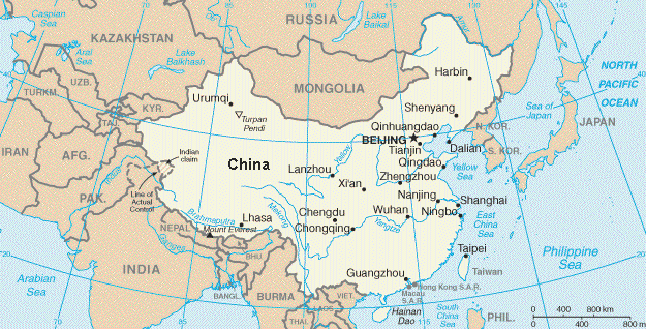China Part 1
Travel The World
Introduction: About China Part I
Location: Eastern Asia, bordering the East China Sea, Korea Bay, Yellow Sea, and South China Sea, between North Korea and Vietnam.
Land boundaries: border countries: Afghanistan 76 km, Bhutan 470 km, Burma 2,185 km, India 3,380 km, Kazakhstan 1,533 km, North
Korea 1,416 km, Kyrgyzstan 858 km, Laos 423 km, Mongolia 4,677 km, Nepal 1,236 km, Pakistan 523 km, Russia (northeast) 3,605 km,
Russia (northwest) 40 km, Tajikistan 414 km, Vietnam 1,281 km
Regional borders: Hong Kong 30 km, Macau 0.34 km.
Chinese customs Go Here

Official Name:
People's Republic of China
Geography:
Total area: 9,596,960 sq. km. (about 3.7 million sq. mi.).
Cities:Capital--Beijing. Other major cities--Shanghai, Tianjin, Shenyang, Wuhan, Guangzhou, Chongqing, Harbin,
Chengdu.
Terrain:Plains, deltas, and hills in east; mountains, high plateaus, deserts in west.
Climate: Tropical in south to subarctic in north.
People
Nationality:Noun and adjective--Chinese (singular and plural).
Population (2006 est.):1.3 billion.
Population growth rate (2006 est.):0.6%.
Health (2006 est.):Infant mortality rate--23.12/1,000. Life expectancy--72.58 years (overall); 70.89 years for males, 74.46 years for females.
Ethnic groups:Han Chinese--91.9%; Zhuang, Manchu, Hui, Miao, Uygur, Yi, Mongolian, Tibetan, Buyi, Korean, and other nationalities--8.1%.
Religions:Officially atheist; Taoism, Buddhism, Islam, Christianity.
Language:Mandarin (Putonghua), plus many local dialects.
Education:Years compulsory--9. Literacy--91%.
Work force (2001 est., 711 million): Agriculture and forestry--50%; industry and commerce--23%; other--27%.
Government
Type:Communist party-led state.
Constitution:December 4, 1982.
Independence:Unification under the Qin (Ch'in) Dynasty 221 BC; Qing (Ch'ing or Manchu) Dynasty replaced by a republic
on February 12, 1912; People's Republic established October 1, 1949.
Branches:Executive--president, vice president, State Council, premier. Legislative--unicameral National People's Congress. Judicial--Supreme People's Court.
Administrative divisions:23 provinces (the P.R.C. considers Taiwan to be its 23rd province); 5 autonomous regions, including Tibet; 4 municipalities directly under the State Council.
Political parties:Chinese Communist Party, 66.35 million members; 8 minor parties under communist supervision.
Suffrage:Universal at 18.
People
Ethnic Groups
The largest ethnic group is the Han Chinese, who constitute about 91.9% of the total population. The remaining 8.1% are Zhuang (16 million),
Manchu (10 million), Hui (9 million), Miao (8 million), Uygur (7 million), Yi (7 million), Mongolian
(5 million), Tibetan (5 million), Buyi (3 million), Korean (2 million), and other ethnic minorities.
Language
There are seven major Chinese dialects and many subdialects. Mandarin (or Putonghua), the predominant dialect, is
spoken by over 70% of the population. It is taught in all schools and is the medium of government. About two-thirds of the
Han ethnic group are native speakers of Mandarin; the rest, concentrated in southwest and southeast China, speak one of
the six other major Chinese dialects. Non-Chinese languages spoken widely by ethnic minorities include Mongolian,
Tibetan, Uygur and other Turkic languages (in Xinjiang), and Korean (in the northeast).
The Pinyin System of Romanization
On January 1, 1979, the Chinese Government officially adopted the pinyin system for spelling Chinese names and places
in Roman letters. A system of Romanization invented by the Chinese, pinyin has long been widely used in China on street
and commercial signs as well as in elementary Chinese textbooks as an aid in learning Chinese characters. Variations of pinyin also are used as
the written forms of several minority languages.
Pinyin has now replaced other conventional spellings in China's English-language publications. The U.S. Government also
has adopted the pinyin system for all names and places in China. For example, the capital of China is now spelled "Beijing" rather than "Peking."



Exciting Places to Visit:
Beijing....the country’s capital which demonstrates most of the country’s cultural heritage.It is the home of history in China.
A tour in Beijing comprises of places like the Forbidden City, the Great Wall of China, the Summer Palace, Tiananmen
Square, the Ming Tombs as well as the Lama Temple.
Religion
Religion plays a significant part in the life of many Chinese. Buddhism is most widely practiced, with an estimated
100 million adherents. Traditional Taoism also is practiced. Official figures indicate there are 20 million Muslims, 5 million Catholics,
and 15 million Protestants; unofficial estimates are much higher.
While the Chinese constitution affirms religious toleration, the Chinese Government places restrictions on religious
practice outside officially recognized organizations. Only two Christian organizations--a Catholic church without official ties
to Rome and the "Three-Self-Patriotic" Protestant church--are sanctioned by the Chinese Government. Unauthorized churches have sprung
up in many parts of the country and unofficial religious practice is flourishing. In some regions authorities have tried to control activities of these
unregistered churches. In other regions, registered and unregistered
groups are treated similarly by authorities and congregations worship in both types of churches. Most Chinese Catholic bishops are recognized
by the Pope, and official priests have Vatican approval to administer all the sacraments.
History
Dynastic Period
China is the oldest continuous major world civilization, with records dating back about 3,500 years. Successive dynasties developed a system of
bureaucratic control that gave the agrarian-based Chinese an advantage over neighboring nomadic
and hill cultures. Chinese civilization was further strengthened by the development of a Confucian state ideology and a common written language
that bridged the gaps among the country's many local languages and dialects. Whenever China was conquered by nomadic tribes, as it was by the
Mongols in the 13th century, the conquerors sooner or later adopted the ways of the "higher" Chinese civilization and staffed the bureaucracy with Chinese.
The last dynasty was established in 1644, when the Manchus overthrew the native Ming dynasty and established the Qing (Ch'ing) dynasty with Beijing as its capital.
At great expense in blood and treasure, the Manchus over the next half century gained control of many border areas, including Xinjiang, Yunnan, Tibet, Mongolia, and Taiwan.
The success of the early
Qing period was based on the combination of Manchu martial prowess and traditional Chinese bureaucratic skills.
During the 19th century, Qing control weakened, and prosperity diminished. China suffered massive social strife, economic stagnation, explosive population growth, and
Western penetration and influence. The Taiping and Nian rebellions, along with
a Russian-supported Muslim separatist movement in Xinjiang, drained Chinese resources and almost toppled the dynasty. Britain's desire to continue its illegal opium trade
with China collided with imperial edicts prohibiting the addictive drug, and the First Opium War erupted in 1840.
China lost the war; subsequently, Britain and other Western powers, including the United States, forcibly occupied "concessions"
and gained special commercial privileges. Hong Kong was ceded to Britain
in 1842 under the Treaty of Nanking, and in 1898, when the Opium Wars finally ended, Britain executed a 99-year lease
of the New Territories, significantly expanding the size of the Hong Kong colony.
As time went on, the Western powers, wielding superior military technology, gained more economic and political privileges. Reformist Chinese officials argued for the adoption
of Western technology to strengthen the dynasty and counter Western advances, but the Qing court played down both the Western threat and the benefits of Western technology.
Early 20th Century China
Frustrated by the Qing court's resistance to reform, young officials, military officers, and students--inspired by the revolutionary ideas of Sun Yat-sen--began to advocate the
overthrow of the Qing dynasty and creation of a republic.
A revolutionary military uprising on October 10, 1911, led to the abdication of the last Qing monarch. As part of a compromise to overthrow the dynasty without a civil war, the
revolutionaries and reformers allowed high Qing officials to retain prominent positions in the new republic. One of these figures, Gen. Yuan Shikai, was chosen as the republic's first president.
Before his death in 1916, Yuan unsuccessfully attempted to name himself emperor. His death left the republican
government all but shattered, ushering in the era of the "warlords" during which China was ruled and ravaged by shifting coalitions of competing provincial military leaders.
In the 1920s, Sun Yat-sen established a revolutionary base in south China and set out to unite the fragmented nation. With Soviet assistance, he organized the
Kuomintang (KMT or "Chinese Nationalist People's Party"), and entered into an alliance with the fledgling Chinese Communist Party (CCP). After Sun's death in 1925,
one of his protégés, Chiang Kai-shek, seized control of the KMT and succeeded in bringing most of south and central China under its rule. In 1927, Chiang turned on the
CCP and executed many of its leaders. The remnants fled into the mountains of eastern China. In 1934, driven out of their mountain bases, the CCP's forces embarked
on a "Long March" across some of China's most desolate terrain to the northwestern province of Shaanxi, where they established a guerrilla base at Yan'an.
During the "Long March," the communists reorganized under a new leader, Mao Zedong (Mao Tse-tung). The bitter struggle between the KMT and the CCP continued openly
or clandestinely through the 14-year long Japanese invasion (1931-45),
even though the two parties nominally formed a united front to oppose the Japanese invaders in 1937. The war between the two parties resumed after the Japanese defeat
in 1945. By 1949, the CCP occupied most of the country.
Chiang Kai-shek fled with the remnants of his KMT government and military forces to Taiwan, where he proclaimed Taipei to
be China's "provisional capital" and vowed to re-conquer the Chinese mainland. Taiwan still calls itself the "Republic of China."